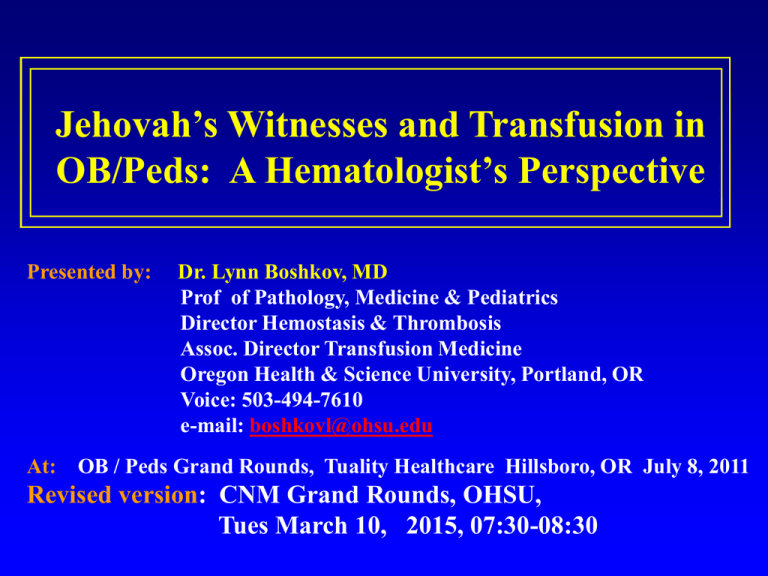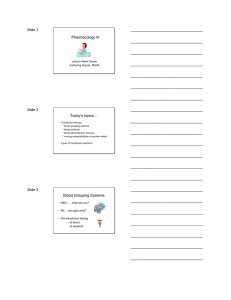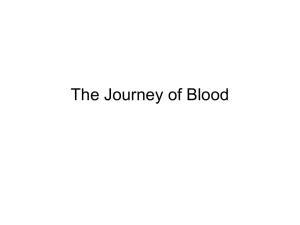Jehovah’s Witnesses and Transfusion in OB/Peds: A Hematologist’s Perspective
advertisement

Jehovah’s Witnesses and Transfusion in OB/Peds: A Hematologist’s Perspective Presented by: Dr. Lynn Boshkov, MD Prof of Pathology, Medicine & Pediatrics Director Hemostasis & Thrombosis Assoc. Director Transfusion Medicine Oregon Health & Science University, Portland, OR Voice: 503-494-7610 e-mail: boshkovl@ohsu.edu At: OB / Peds Grand Rounds, Tuality Healthcare Hillsboro, OR July 8, 2011 Revised version: CNM Grand Rounds, OHSU, Tues March 10, 2015, 07:30-08:30 Disclosures: None Jehovah’s Witness Patients: • General principles to follow in working with JW patients • What’s Acceptable? • The Pediatric Patient of JW Parents • How Low Can You Go? • Cases Illustrating Options in the Adult Ob Gyn Setting Jehovah’s Witness Patients: General Suggestions for Health Care Providers • Work in partnership with the patient & JW community; act as patient’s advocate. • Know & explore the acceptability of the full range of non-blood therapeutic options with the patient--and use them!! • Act pre-emptively if possible • Realize physiological tolerance of anemia is generally greater than you may think Jehovah’s Witnesses: What’s Acceptable? • Religious objection to the use of many blood products • Acceptability of blood products: Unacceptable: Whole blood and its primary components: RBCs, platelets, plasma, WBCs Possibly acceptable (individual conscience): Plasma derivatives: cryoprecipitate, albumin, fibrin glue, factor concentrates, IVIG, (Hb-based O2 carriers) UNACCEPTABLE Whole Blood 450 ml Primary Components Plasma (~250 ml) spin Platelets WBCs RBCs (~200 ml) MAY be acceptable: “MATTERS OF CONSCIENCE” Plasma derivatives “fractions” Hb-based O2 carriers (experimental) Plasma Derivatives = “Matters of Conscience” spin Cryoprecipitate ~10 ml Plasma ~250 ml, 4o C Fibrin glue (~1/2 the VWF, FVIII and fibrinogen in original plasma) Physical and/or chemical separation (s) 2000 - 20,000 donors Plasma pools + thrombin Albumin Clotting Proteins Ex. Prothrombin Complex Concentrates =PCCs= Factors II, VII,IX, X Ex. FVIII, FIX-from plasma IVIG; RhIg Many others • Acceptability of transfusion -sparing interventions: • Unacceptable: Autologous predonation • Conditionally acceptable (with certain devices/techniques only--blood must remain in unbroken circuit with body) : Isovolemic hemodilution, some perioperative salvage devices • Almost always acceptable: Epo • Always acceptable (no issues): darbe (albumin free), G-CSF, TPO-mimetics, ddAVP, antifibrinolytics, recombinant factors, rVIIa “Tips” on explaining “fractions” and transfusion alternatives : • Ask if the patient has an “Advance Directive”— there is a special section of this dealing with “fractions” • Use a special “Refusal Form” to help guide discussion between you and the patient (OHSU = possible prototype) • Usually if one “fraction” is acceptable, all are • Erythropoietin = “matter of conscience” (stabilized with traces of albumin); darbepoietin = no issues (albumin free) “Tips” on explaining “fractions” and transfusion alternatives : 2 It may be helpful to emphasize: • Plasma’s role as a general carrier (sugars, waste products, clotting factors, etc) • The fact that clotting proteins are made in the liver and traffic normally across the placenta whereas • cellular blood elements (RBCs, platelets, WBCs ) are made in the bone marrow and don’t That although neither platelets nor plasma are acceptable to Witnesses that: • • • • cryoprecipitate can help platelets work better PCC s + cryo can supply many clotting factors (every factor in clotting cascade except V and XI) fibrin glue can help make local clots albumin can help blood stay in the vessels Additional Management “Tips”: • The “fractions”/transfusion alternatives discussion is useful and should be done: • I have seen all named fractions contribute to saving lives • The therapeutic relationship is served • Don’t be shy about asking for advice elsewhere— call me, call Dr David Rozencrantz at Legacy • Ask if the patient has a specially trained Hospital Liaison Elder working with them—these individuals are often knowledgeable and compassionate and can help both the patient and the treating MD OHSU BLOOD REFUSAL FORM Transfusion of Minors poses medical legal issues BUT…Court Orders are NOT often necessary at OHSU: Re: Care of the Child of JW Parents re: Blood Refusal: The same principles apply as before…. 1. Work in partnership with the patient & JW community; act as patient’s advocate—Hospital Liaison Elder involvement in the case and with the treating MD is very reassuring to the family 2. Know & explore the acceptability of the full range of “matters of conscience” and non-blood therapeutic options with the patient and the family--and use them!! ex. cryoppt vs platelet txn in severe thrombocytopenia; romiplostim to increase platelet counts 3. Act pre-emptively if possible ex. IV iron and epo to treat anemia pre-op in patients coming to major surgery—and accelerate Hb recovery post-op (Note: darbe not approved in peds) ex. Iron, epo, folate, B12, Vit K routinely as appropriate Note: Pre-op epo: 300-500 U/kg /wk—takes 2-3 weeks to get meaningful increase in Hb Post-op epo: 300-500 U/kg/d SQ--works less well due to antagonism by inflammatory mediators 4. Realize physiological tolerance of anemia is generally greater than you may think Ref: LaCrox J et al Transfusion strategies for patients in pediatric ICUs NEJM 2007; 356: 1609-1619— Hbs 7-9 vs 10-12 usually OK in peds 5. Make the family aware of the legal obligation of the MD to transfuse a minor to prevent death or serious harm. Note: If the family has truly seen you work to avoid transfusion of their child; and if you have worked with a JW Liaison elder; and if you have communicated clearly with them why you think the situation has become life threatening; and if you have avoided getting a court order for the now-necessary transfusion—or worked to get the court order limited to transfusion only—then you have done all you could—and they know it and are often grateful to you—esp after the emotionally charged moment of the transfusion has passed Note: I often sit with the family during the transfusion and talk with them and the patient; I give sedatives as appropriate and cover the blood bag with a pillowcase and the IV tubing with foil For a fuller discussion of “Care of the Child Refusing Blood Products” see Chapt 449 in Textbook of Pediatrics, 2nd ed, 2012 OK, now back to adults and anemia tolerance…….. Hb/ Hct: How Low Can You Go? • Normal Hb: ~12-16 g/dl; Hct ~36-56 • Response to anemia: • Cardiac: HR, coronary vasodilatation, as decompensate: shift to anaerobic metab; blood from subendo epicardium • Peripheral tissues: blood flow thru vascular beds; O2 extraction (if possible); recruit more capillaries • RBC 2,3 DPG: facilitates off-loading O2 to tissues • Animal studies: lower limit tolerance: • Normal CV system: Hb ~3-5 g/dl • Coronary stenosis: Hb ~7-10 g/dl • Human perisurgical morbidity/mortality: Post-Op Hb 30d in hospital mortality 30d morbidity/mortality Normal CV disease Normal CV disease 1.1-2.0 100 % 100 % 100 % 100 % 2.1-3.0 52.6 % 60 % 88.9 % 100 % 3.1-4.0 10.0 % 62.5 % 42.9 % 80.0 % 4.4-5.0 20.0 % 58.3 % 50.0 % 75.0 % 5.1-6.0 7.5 % 14.3 % 23.5 % 40.0 % 6.1-7.0 11.4 % 0% 22.5 % 20.0 % 7.1-8.0 0% 0% 9.8 % 7.1 % Tolerance to anemia is determined by multiple factors including: Chronicity of development Underlying cardiovascular status Age O2 demands One size does not necessarily fit all… And now on to some Ob/Gyn patient cases….






